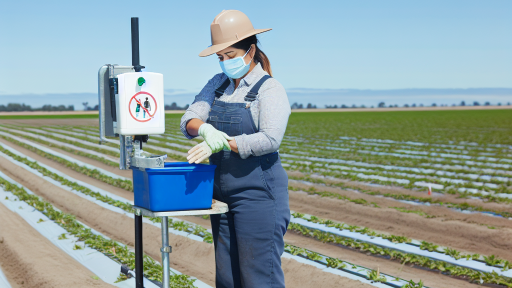Introduction to Pesticide Labels
Importance of Pesticide Labels
Pesticide labels provide essential information for safe use.
They guide users on proper application methods.
Furthermore, labels help users understand potential hazards.
They also inform about protective measures users should take.
Purpose of Pesticide Labels
The primary purpose of pesticide labels is safety.
Labels educate users about product contents and concentrations.
They outline the appropriate usage rates for various applications.
Additionally, labels specify any environmental precautions necessary.
Legal Requirements
Pesticide labels must comply with regulations set by authorities.
The Environmental Protection Agency mandates specific labeling practices.
Each label should contain clear and accurate information.
Compliance ensures safe usage and minimizes legal repercussions.
Key Components of Pesticide Labels
Labels typically include product identification details.
They list active ingredients and their concentrations.
Users find usage directions and application methods within labels.
Transform Your Agribusiness
Unlock your farm's potential with expert advice tailored to your needs. Get actionable steps that drive real results.
Get StartedIt’s crucial to review warning statements provided on the label.
Also, labels often include first aid instructions for emergencies.
Types of Pesticides
An Overview of Categories and Usage
Pesticides play a crucial role in agriculture and pest management.
Understanding their types helps in their effective usage.
Herbicides
Herbicides specifically target unwanted plants or weeds.
They prevent competition with crops for nutrients and sunlight.
Farmers use them to enhance crop yield significantly.
Insecticides
Insecticides are designed to manage insect pests.
They protect crops from damage caused by various insects.
Effective use ensures healthier plants and better harvests.
Fungicides
Fungicides combat fungal infections affecting plants.
They help in preserving the quality and quantity of crops.
Utilizing them correctly can prevent significant losses.
Rodenticides
Rodenticides target rodents that harm crops and stored grains.
They are essential in maintaining crop integrity and storage safety.
Farmers must apply them responsibly to minimize risks to non-target species.
Acaricides
Acaricides are employed to control mites and ticks.
They are crucial for protecting various crops from infestation.
Appropriate application can lead to healthier plant growth and yield.
Biopesticides
Biopesticides utilize natural organisms or substances.
They offer an environmentally friendly alternative to traditional pesticides.
Farmers increasingly favor them for sustainable farming practices.
Usage Guidelines
Proper identification of pests and diseases is vital.
Choose the right type of pesticide for effective control.
Showcase Your Farming Business
Publish your professional farming services profile on our blog for a one-time fee of $200 and reach a dedicated audience of farmers and agribusiness owners.
Publish Your ProfileRead labels and follow instructions for safe application.
Implement integrated pest management practices where possible.
Key Components of Pesticide Labels
Essential Information
Pesticide labels carry vital information for safe usage.
They include directions on how to apply the product effectively.
Furthermore, they highlight potential risks associated with the pesticide.
Active Ingredients
The label lists the active ingredients, identifying the chemical components.
This section informs users about what they are applying.
It helps in understanding the effectiveness against specific pests.
Signal Words
Signal words indicate the level of toxicity of the pesticide.
Words like “Caution,” “Warning,” or “Danger” provide immediate alerts.
These words help users assess the potential risks before using the product.
Usage and Application Instructions
Clear instructions guide users on how to apply the pesticide safely.
These directions include proper dilution rates and application methods.
Moreover, they suggest when to apply the product for maximum effectiveness.
Safety Precautions
Pesticide labels include safety precautions to protect users.
Wearing protective gear is often recommended during application.
Additionally, labels include instructions on what to do in case of exposure.
Environmental Considerations
Labels address the environmental impact of pesticide use.
They provide information on how to minimize harm to non-target organisms.
Users can find guidelines on proper disposal and storage as well.
Regulatory Information
Pesticide labels often display registration numbers from regulatory agencies.
This information ensures that the product meets safety standards.
It also allows users to verify the product’s legitimacy.
Contact Information
Labels usually provide contact information for the manufacturer.
This enables users to reach out for further inquiries or assistance.
Thus, knowing whom to contact can clarify uncertainties related to the product.
You Might Also Like: Leveraging Research Funding to Innovate and Grow Your Farming Operation
Understanding Active Ingredients
Definitions of Active Ingredients
An active ingredient is a substance that targets pests directly.
It is the component responsible for a pesticide’s effectiveness.
Understanding active ingredients is crucial for safe pesticide use.
Examples of Common Active Ingredients
Certain active ingredients are well-known in the agriculture industry.
For example, glyphosate is widely used to manage weeds.
Another common ingredient is pyrethrin, which targets insect pests.
These ingredients play essential roles in pest control strategies.
Farmers should be aware of their specific functions and applications.
Types of Active Ingredients
Active ingredients can be classified into various categories.
Some are synthetic, while others are derived from natural sources.
Synthetic ingredients often have greater potency against pests.
Natural ingredients may offer a more eco-friendly alternative.
It is important to match the type of ingredient with the intended use.
Showcase Your Farming Business
Publish your professional farming services profile on our blog for a one-time fee of $200 and reach a dedicated audience of farmers and agribusiness owners.
Publish Your ProfileRegulatory Considerations
Regulatory frameworks govern the use of active ingredients in pesticides.
Organizations like the Environmental Protection Agency (EPA) oversee these regulations.
They ensure that active ingredients meet safety and efficacy standards.
Manufacturers are required to provide detailed information about all components.
This includes potential risks to human health and the environment.
Significance of Understanding Active Ingredients
Knowledge about active ingredients promotes responsible pesticide use.
Farmers can make informed choices about the products they apply.
This understanding ultimately contributes to sustainable agricultural practices.
Additionally, it helps in maintaining crop health and yield.
Consequently, awareness leads to better environmental stewardship.
Find Out More: The Role of Animal Welfare Laws in Modern Farming Practices
Signal Words on Labels: What They Indicate About Risk Levels
Overview of Signal Words
Signal words serve as quick indicators of pesticide risks.
They help users understand the potential dangers involved with a product.
Common signal words include “Caution,” “Warning,” and “Danger.”
Caution
The word “Caution” indicates the lowest level of risk.
Products labeled with “Caution” may cause mild irritation.
Users should still take precautionary measures when using these products.
Warning
“Warning” signifies a moderate level of risk associated with the product.
Exposure may result in more serious health effects.
Users are advised to handle these products with extra care.
Danger
The word “Danger” points to products with the highest risk.
These pesticides may cause severe health effects from short exposure.
It is critical to follow safety guidelines strictly when using these products.
Other Important Labels
In addition to signal words, precautionary statements are essential.
These statements detail specific risks and recommended safety measures.
Understanding these can help ensure user safety and product efficacy.
Understanding Risk Levels
Each signal word reflects increasing risk levels from low to high.
This hierarchy assists users in making informed decisions.
Always read the entire label for detailed safety information.
Uncover the Details: Understanding Climate Change Laws for Modern Farmers
Application Instructions: Proper Usage for Safety and Efficacy
Understanding Labels
Labels contain essential information about pesticide products.
Each label provides specific usage instructions.
Read the label thoroughly before applying the pesticide.
This ensures both safety and effectiveness.
Preparation for Application
Gather all necessary protective equipment before use.
Wear gloves, goggles, and a mask to prevent exposure.
Ensure the area is well-ventilated during application.
Identify the target pests and determine the proper pesticide.
Application Techniques
Apply pesticides during calm weather to reduce drift.
Use appropriate application equipment to ensure even coverage.
Showcase Your Farming Business
Publish your professional farming services profile on our blog for a one-time fee of $200 and reach a dedicated audience of farmers and agribusiness owners.
Publish Your ProfileAvoid over-application to minimize environmental impact.
Follow the label instructions regarding the quantity of pesticide.
Post-Application Practices
Keep people and pets away from treated areas until dry.
Store any leftover pesticide in its original container.
Dispose of empty containers according to local regulations.
Monitor the treated area for pest control effectiveness.
Emergency Procedures
Have an emergency plan in case of pesticide exposure.
Know the first aid measures listed on the label.
Keep the poison control number accessible at all times.
Immediately seek medical attention for any serious reactions.
You Might Also Like: How To Apply For Agricultural Conservation Programs

Storage and Disposal Guidelines
Importance of Proper Storage
Proper storage of pesticides ensures safety and effectiveness.
Always store pesticides in a locked area away from children and pets.
Consider using a designated storage cabinet for larger quantities.
Ensure that the storage area is cool, dry, and well-ventilated.
Labeling for Safety
Clear labeling is essential for safe pesticide storage.
Keep all original labels intact and legible.
Use color-coded systems for different pesticide types if needed.
Disposal Guidelines
Follow local regulations for pesticide disposal.
Never pour pesticides down the drain or on the ground.
Use approved collection programs for hazardous waste.
Consider recycling options for empty pesticide containers.
Personal Protective Equipment (PPE)
Use appropriate PPE when handling pesticides.
Wear gloves, goggles, and masks to prevent exposure.
Ensure that PPE is clean and in good condition before use.
Emergency Procedures
Have emergency procedures ready for pesticide spills or exposure.
Establish a clear plan for reporting incidents quickly.
Store emergency contact numbers in an accessible location.
Regulatory Bodies and Compliance
Key Regulatory Agencies
The Environmental Protection Agency (EPA) oversees pesticide registrations in the United States.
This agency sets standards to ensure pesticides are safe for human health and the environment.
Each state has its own regulatory body that enforces these standards at a local level.
Moreover, the U.S. Department of Agriculture (USDA) supports these efforts through agricultural initiatives.
Pesticide Labeling Requirements
Pesticide labels must include specific information mandated by regulatory agencies.
Labels must clearly state the product’s intended use, applying it directly to the crop types.
Additionally, they must contain precautions for safe handling and application.
Furthermore, labels highlight any potential risks to humans, pets, and beneficial organisms.
Importance of Compliance
Compliance with labeling requirements is critical for maintaining agricultural safety.
Failure to comply can result in significant fines and operational setbacks for businesses.
Moreover, improper labeling can lead to environmental damage and public health risks.
Therefore, businesses must regularly review and update their labels to meet current standards.
Showcase Your Farming Business
Publish your professional farming services profile on our blog for a one-time fee of $200 and reach a dedicated audience of farmers and agribusiness owners.
Publish Your ProfileAssessment and Penalties
Regulatory bodies conduct regular assessments of pesticide labels for compliance.
They check if the labels reflect the most recent scientific findings and regulations.
Non-compliance can lead to actions such as product recalls or bans on sales.
In severe cases, companies can face legal litigation or criminal charges.
Common Misinterpretations of Labels: Myths vs. Facts
Myth: All Pesticides Are Harmful
Many people believe that all pesticides are inherently harmful.
In reality, pesticides vary in safety based on their formulation and usage.
Some pesticides are designed to minimize environmental impact.
Additionally, using pesticides as directed enhances safety and efficacy.
Fact: Regulations Ensure Pesticide Safety
Regulatory agencies evaluate pesticides before they reach the market.
They ensure products meet rigorous health and safety standards.
These agencies conduct extensive research and testing.
Thus, approved pesticides are safe when used properly.
Myth: The Label Contains Confusing Terminology
Some consumers think pesticide labels are filled with jargon.
However, label terms are standardized to promote understanding.
Reading pesticide labels can become simpler with practice.
Many resources are available to help decode terminology.
Fact: Labels Provide Vital Information
Pesticide labels include essential details for safe usage.
This information encompasses active ingredients, usage rates, and safety measures.
Labels also specify the target pests and application methods.
Consequently, following label guidelines ensures effective pest control.
Myth: Using More Pesticide Equals Better Results
Some believe that applying larger amounts of pesticide improves outcomes.
This misconception can lead to harmful environmental effects.
Over-application often results in pesticide resistance among pests.
Using the recommended amounts maximizes effectiveness without risking harm.
Fact: Timing and Method Are Crucial
The timing of pesticide application significantly impacts effectiveness.
Different pests have specific life cycles demanding targeted treatments.
Moreover, application methods directly influence exposure levels.
Understanding these aspects enhances pest management outcomes.
Myth: Organic Products Are Completely Chemical-Free
Many consumers assume organic pesticides use no chemicals at all.
In truth, organic pesticides can contain natural substances that are still chemicals.
These substances vary in safety and require careful handling.
Organic does not imply that a product is risk-free when misused.
Resources for Further Understanding
Websites
Several reputable websites provide extensive information about pesticide label requirements.
The Environmental Protection Agency (EPA) offers a comprehensive resource on this topic.
You can visit their website for various guides and updates.
The National Pesticide Information Retrieval System (NPIRS) is another useful site.
It helps users access information on pesticide labels and related queries.
Additionally, the American Association of Pesticide Control Officials offers valuable insights.
Publications
Numerous publications delve into pesticide regulation and labeling.
The “Pesticide Labeling: A Guide for Pesticide Users” is a must-read publication.
Showcase Your Farming Business
Publish your professional farming services profile on our blog for a one-time fee of $200 and reach a dedicated audience of farmers and agribusiness owners.
Publish Your ProfileIt details essential labeling requirements for various pesticide types.
The “Pesticide Registration Handbook” is another recommended resource.
This handbook outlines the process of pesticide registration and labeling requirements.
Extension services from universities often publish relevant studies and guides.
Their literature typically addresses state-specific regulations and best practices.
Additional Learning Resources
Online courses and webinars can enhance your understanding of pesticide labeling.
Organizations like the National Pesticide Safety Education Center offer valuable training.
These programs are designed for various audiences, from consumers to professionals.
Local agricultural extension offices also provide workshops on pesticide safety.
They often feature experts discussing the nuances of label requirements.
Additional Resources
Introduction to Pesticide Labels | US EPA
Understanding Agricultural Law – Center for Agricultural and Shale …




